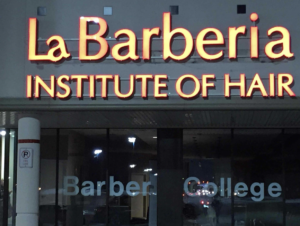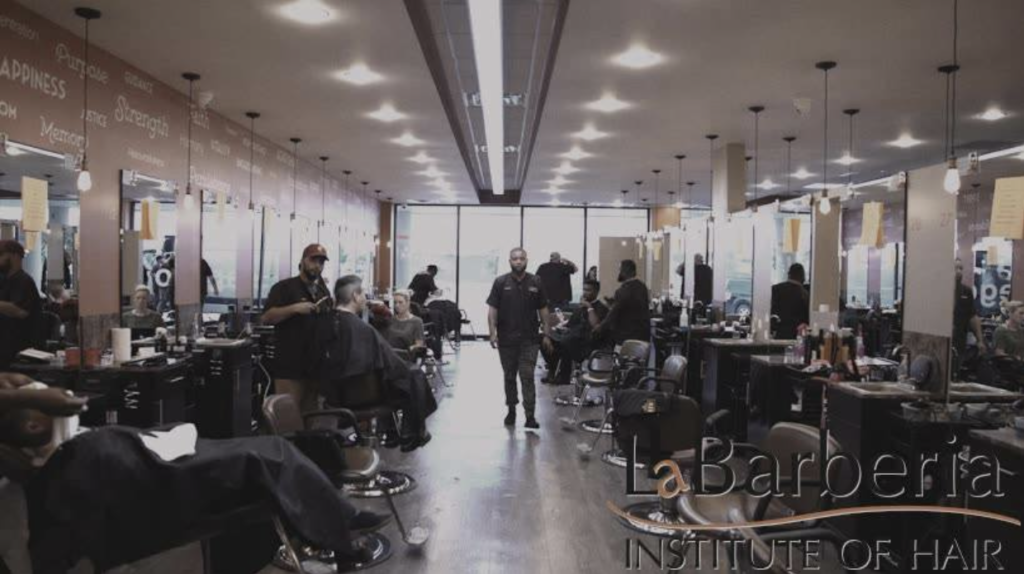The LaBarberia Institute of Hair sits between a T.G.I. Friday’s and a small tailor shop in Mayfield, Ohio. The barber school trains students to take the Ohio state mandated licensure exam, but founder and owner Laura Clemente has created an environment that does so much more. LaBarberia is a community fixture, known for offering free or low cost hair styling to individuals who cannot afford it otherwise. Although the school has been a center for community engagement since its opening in 2009, it has only recently become a center for political advocacy.
Since the beginning of 2018, LaBarberia has served as a meeting place for a movement of beauty professionals questioning the ethics of the newly merged Ohio State Cosmetology and Barber Board and campaigning against harmful legislation. This legislation—Substitute House Bill 189 and Senate Bill 129—threatens to cut cosmetology education, thus causing Ohio cosmetologists to lose reciprocity with forty-six other states, harming the ability of independent practitioners to compete with chain salons, and posing potential hazards to public safety. A petition against the bills has amassed over 6000 signatures.
Moreover, several members of the Ohio State Cosmetology and Barber Board who own large salons that would benefit from the cuts have spoken publicly in favor of the board, making Ohio beauty professionals uneasy. Waverly Willis, owner of Urban Kutz, the highest-rated barber shop in Cleveland, expressed concern to the HPR, saying, “It’s an insult that these board members have a—you know, I want to use the term hidden agenda, but it’s not even hidden.”
Barbers and cosmetologists across the state of Ohio have expressed similar concerns, and several have filed ethics complaints against specific board members. The complicated nature of conflict of interest law, however, has made legal recourse for these ethics complaints nearly impossible. The Ohio State Cosmetology and Barber Board presents a case study in conflict of interest law, demonstrating the inefficiency of the law in mitigating private interests within American bureaucracies.
The Board and the Bill

LaBarberia Institute has become a community fixture since its opening in 2009.
The merger of the cosmetology and barber boards, which created an initial cause for controversy regarding board ethics, was included in a 2017 spending bill in the Ohio state legislature. When the boards merged, only two of 13 positions were specifically assigned to barbers, with 10 remaining for cosmetologists and one for a public member. This structure left barbers feeling underrepresented, with LaBarberia Institute of Hair administrator Christina Mel explaining to the HPR that barbers are distrustful because “only one” of the two positions allocated to barbers have been filled “five, six months later.” Mel continued to comment that barbers feel “outnumbered on our own board.”
Tension with the board increased when barbers and cosmetologists learned about Substitute House Bill 189. The bill threatened not only to cut cosmetology training hours from 1500 to 1000 hours, but it also limited access to federal funding for advanced licensure. The decrease in education would cause Ohio to lose reciprocity with 46 other states, all of which require 1500 hours or more of cosmetology education. Barbers, who currently have an 1800 hour training program, worry that cuts to their education will be next.
These provisions of the bill were controversial. Willis, who has been cutting hair since he was eight years old as a “hobby born out of necessity,” explained that the bill “could make disease run rampant.” According to Willis, a substantial part of barber and cosmetology education is learning how to identify potential disease risks and maintain sanitary instruments, something that barbers struggle with “even at the end of an 1800 hour educational program.” Willis also expressed concerns over how decreased licensure requirements would impact new independent practitioners who struggle even now to compete against experienced barbers and cosmetologists.
HB-189 also proposed substituting traditional training programs with apprenticeship programs in salons, citing faster student loan repayment as a motivating factor. Clemente, who formerly owned three salons of her own, told the HPR that while large salons can pay for in-house educators, “a mom-and-pop shop cannot afford to pay someone minimum wage to learn, and to pay someone to teach them. It would hurt their hiring capabilities.” Clemente went on to explain how apprenticeship programs benefit large salons because it allows them to lock new professionals into extensive non-compete contracts, forcing them to work at a particular salon for a designated period of time.
Still, the real controversy was ignited when beauty professionals discovered that several board members are connected to the bill or organizations that supported it, and would benefit directly from the measures it proposed. Board member Charles Penzone, for example, owns two of the largest salons in the United States, while board member Clara Osterhage owns 62 Great Clips franchises, making her the top franchise owner in the state of Ohio. Both organizations use frequent non-compete contracts, and Penzone sued a former employee on the basis of such a contract in 2006.
The Ohio Salon Association, an organization of which Penzone and Osterhage are founding members, submitted proponent testimony on HB-189, asking their supporters to support the bill using a link on their website. Moreover, Osterhage submitted direct proponent testimony on behalf of Substitute House Bill 189. Penzone submitted proponent testimony on behalf of Senate Bill 129, a similar bill that proposed cuts to the educational programs of beauty professionals.
Wezlynn Davis, a business owner, licensed esthetician, and educator, told the HPR that while these actions alone made licensees uneasy, the relationships surrounding HB-189 only served to increase distrust. According to Davis, when one examines the organizations involved in the creation and support of the bill, they “will see a very incestuous situation.” She explained that there are three organizations who have been fighting for educational reform across the country: the Future of the Beauty Industry Coalition, the Professional Beauty Association, and the International SalonSpa Business Network. Interestingly, the CEO of Great Clips, the organization of which Osterhage is the top franchise owner in the state of Ohio, is Rhoda Olsen, who is also involved with the FBIC and serves as the President of the ISBN. An ISBN progress report cited board members Osterhage and Penzone as leaders of the Ohio effort for educational cuts. Moreover, Osterhage is listed as a “state captain” for the PBA’s version of a similar movement, along with fellow board member Rowena Yeager.
Davis thus expressed what she explained had become a sentiment common among Ohio beauty professionals: “All of these things are tied together, and they don’t feel good. They don’t feel right. It makes us uneasy.” This unease fueled citizen action. Barbers, cosmetologists, and beauty students across the state of Ohio flooded the phones and emails of Ohio representatives to prevent them from voting on the bill before the summer recess, and on June 26, 2018, the Ohio House of Representatives recessed for the summer without voting. Nonetheless, beauty professionals have continued to mobilize across Ohio to address what they view as conflicts of interest on the board.
Flaws in the Laws
Ambiguity in ethics law creates a heavy roadblock to further citizen action. Ohio Revised Code states that “a potential conflict of interest exists if the private interests of the person … might interfere with the public interests the person is required to serve.” Any ethics complaints are reviewed by the bipartisan Ohio Ethics Commission.
Though this law may seem simple, it is difficult to establish a violation of Ohio ethics code. In order to have an illegal conflict of interest, one must directly use their public position to serve private interests. The actions of the state board members thus far can be defended as actions they took as private citizens, outside of their capacities as board members, making legal recourse unlikely. This small debate on the ethics of a state regulatory agency in Ohio thus poses larger questions about the state of American conflict of interest law in general.
Still, the mere existence of a cohesive bureaucratic ethics code is a recent development in American history. Public Law 96-313, the first of its kind, was signed by President Jimmy Carter in 1980, but the law only offers general recommendations to bureaucrats. Each government agency maintained its own code of ethics until 1990, when President George H. W. Bush signed Executive Orders 12674 and 12731 in October of 1990, establishing the principle of a generalized standard. Three years later, the United States Office of Government Ethics released a standardized code of ethics for executive employees.
Executive Order 12731 and the USOGE code establish 14 standards for the behavior of government officials, setting a tone of ambiguity in bureaucratic ethics law in general. These include provisions prohibiting insider trading, outlawing appointment promises, and requiring the disclosure of any knowledge of fraud or waste in government agencies. While these standards are straightforward, certain clauses of the executive order are subjective and difficult to enforce for bureaucratic representatives, such as those which state that government employees “shall not hold financial interests that conflict with the conscientious performance of duty” and “shall not use public office for private gain.” These clauses only serve to provide further questions—for example, what constitutes a direct use of public office? And likewise, is an indirect holding of financial interests prohibited, and how can such an interest even be measured?
After listing these standards, the code continues for nearly 100 pages, but fails to establish any clear standards for the enforcement of conflict of interest law. For example, section 2635.403 allows each separate government agency to determine what constitutes a prohibited financial conflict of interest. But, this decision relies on an arbitrary designee to find that “the acquisition or holding of such financial interests would cause a reasonable person to question the impartiality and objectivity with which agency programs are administered.” Such a standard leaves conflict of interest determinations up to the very individuals who may be violating them.
The ambiguity of these standards is further complicated by the distinction between private and public action. As private citizens, there is nothing prohibiting bureaucratic officials from donating to candidates, participating in political organizing, and lobbying for special interest legislation. To technically demonstrate a conflict of interest, a public official would have to act on their private interests through the explicit use of their public position.
These standards not only imply that individuals can wholly separate their private interests from their public responsibilities, but also assume that they will place the interests of the public above their own. They allow public officials to act on their own behalf, and their actions remain legal so long as they do not explicitly use their public position.
Moving Forward

The interior of LaBarberia Institute.
Until subjectivity and ambiguity are decreased in ethics law, it remains a citizen responsibility to combat behavior that they find unethical. Ohio state beauty professionals have continued to do that. Clemente and other beauty professionals have been attending state board meetings in Columbus every month, an event that they refer to as “babysitting the board.” They have begun to form an Ohio labor union to assist beauty professionals working for minimum wage and under non-compete contracts at large salons and franchises, and to give them a better chance at salary negotiations.
The responsibility of finding and correcting conflicts of interest, however, should not fall on citizens. The creation of a standardized bureaucratic ethics code was a major step forward in American law, but immense work must still be done in order to create a system that is effective in mitigating bureaucratic conflicts of interest. This work must begin with a basic acknowledgment of the reality of bureaucracy: it is impossible to wholly dissociate one’s private interests from their public responsibilities, especially when one holds concurrent public and private positions.
Until this is acknowledged in law, it will be up to citizen activists like Clemente to continue to fight for change—a fight they will bring to the ballot box come November.
Image Credits: Laura Clemente/LaBarberia Institute
